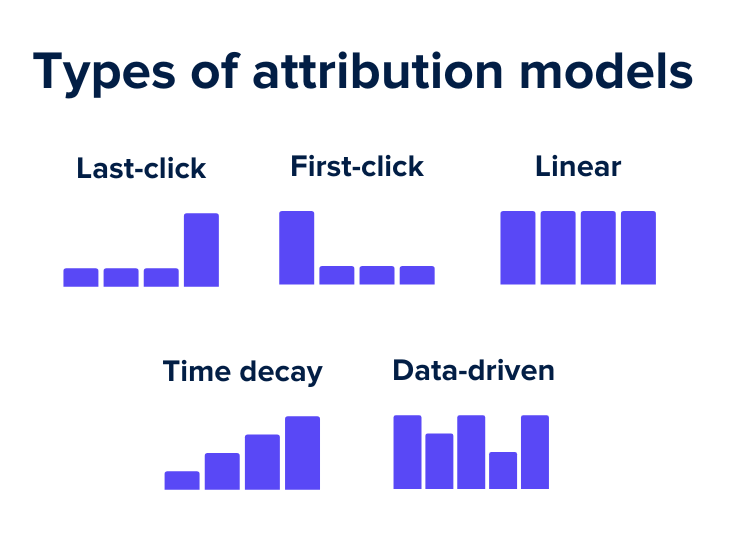
Cross-Channel Marketing Attribution And Tracking Marketing ROI
Intro
You’ve probably heard the term “marketing attribution” thrown around a few times. But how many business owners grasp its full importance in the digital world they’re competing in?
We live in an era when the average consumer’s attention is more fragmented than ever. They bounce from Instagram to email, over to YouTube, and maybe they’ll see your billboard downtown. Capturing and making sense of their journey can be like trying to solve a Rubik’s Cube blindfolded.
Sometimes, your business’s marketing data may seem like you are looking into a bowl of spaghetti and trying to find the start and end of each noodle. Everything is intertwined, and figuring out which marketing efforts drive sales feels nearly impossible.
That’s where the power of cross-channel marketing attribution comes into play—it’s the key to unlocking where to double down your investment and where to cut your losses.
ROI—Return on Investment is the holy grail for business owners. They are in this to make money, grow, and succeed. However, tracking ROI across channels can feel like chasing a moving target. The business world doesn’t sit still, nor should our strategies for measuring success.
This article delves into cross-channel marketing attribution and tracking marketing ROI. We’ll tackle the challenges, demystify the jargon, and equip you with the strategies you need to thrive in this digital jungle. Let’s get started, shall we?
What is Cross-channel Marketing Attribution?
Imagine navigating through a maze with various signs pointing you in different directions. At the end, when you successfully exit, you reflect on which signs were most helpful. Was it the first sign that got you on the right path, the ones in the middle that kept you going, or the final sign that directly led you to the exit? Each sign plays a crucial role in your journey, just like different marketing channels contribute to guiding a customer toward a purchase.
This is what cross-channel marketing attribution is all about. It’s the art and science of figuring out which marketing channels (social media, email, billboards) persuade people to buy from you. Each channel is like a sign in the maze, contributing to the final decision.
Often, when owners try to scale their business, they give too much credit to the last click—the last channel a buyer interacts with before making a purchase. It’s like only valuing the last sign you followed in the maze, completely ignoring those that got you near the end. Understanding and valuing each touchpoint allows you to allocate your budget more effectively and boost your marketing ROI.
What are marketing attribution models?
Let’s examine them more thoroughly, analyzing their pros and cons, where they are best applied, and some real-world examples for better understanding.
Last-Click Attribution
Pros: It’s straightforward to implement and understand, giving explicit credit to the final touchpoint.
Cons: It ignores the journey’s complexity, overlooking earlier engagements that may have been crucial to a conversion.
Practical Application: Useful for businesses with short sales cycles or those focusing on direct response campaigns.
HelloFresh uses direct-to-consumer marketing strategies like social media ads, email marketing, and promotional offers to attract potential customers. They offer a significant discount on the first purchase through social media ads, streamlining the sign-up process to convert visitors into customers quickly. This marketing tactic is designed for rapid conversions, showcasing how HelloFresh successfully navigates the challenges of a short sales cycle while maximizing the impact of direct response campaigns.

First-Click Attribution
Pros: Highlights the importance of initial engagement, identifying which channels are best at starting buyer journeys.
Cons: Like its last-click counterpart, it oversimplifies by ignoring the influence of subsequent touchpoints.
Practical Application: Great for measuring the effectiveness of top-of-funnel activities, especially in awareness campaigns.
Coca-Cola excels at creating engaging content that builds brand awareness and emotional connections with audiences worldwide. The “Share a Coke” campaign, where bottles were personalized with names, was primarily spread through social media, outdoor advertising, and TV commercials, boosting brand awareness and engagement. Using creative content, Coca-Cola attracts potential customers into its marketing funnel, highlighting the importance of top-of-funnel activities in building a successful awareness campaign.
Linear Attribution
Pros: Linear attribution is a democratic approach acknowledging every touchpoint’s contribution, offering a more balanced view.
Cons: Can dilute the impact of critical touchpoints that might play a more significant role in the conversion process.
Practical Application: This works well for brands with multifaceted marketing strategies that aim to maintain consistent engagement across the customer journey.
Nike engages with its audience at various touchpoints using social media, influencer partnerships, email marketing, personalized online experiences, and dynamic retargeting ads.
For instance, someone might see a new shoe release on Nike’s Instagram and receive an email about the same product because they subscribed to the newsletter. Later, while browsing other websites, they might encounter retargeting ads for the shoe they viewed but didn’t purchase.
Each interaction is tailored and consistent, keeping Nike top-of-mind throughout the customer’s journey, from awareness to purchase. This approach demonstrates the practical application of a comprehensive marketing strategy that spans multiple channels and touchpoints, ensuring that Nike remains engaged with its consumers at every step.
Time-Decay Attribution
Pros: It adds nuance by valuing the recency of engagements and acknowledging that later interactions might be more influential.
Cons: While it addresses some of the simplicity of other models, it may still undervalue early touchpoints.
Deal for longer sales cycles where recent interactions are likely more indicative of purchase intent.
HubSpot is a top software provider for inbound marketing, sales, and customer service. They excel in nurturing leads through content, email sequences, and personalized follow-ups, tailoring their approach based on recent interactions to move leads closer to a decision. By offering resources like blogs, e-books, and free tools, businesses can engage potential customers at various stages of their journey. This showcases how focusing on the quality and recency of interactions can influence purchase intent.
Data-Driven Attribution
Pros: The most sophisticated, leveraging algorithms use a data-driven approach, weighing each touchpoint’s impact on the final decision.
Cons: Requires significant data and can be complex to implement and understand.
It is best for larger businesses with the resources to analyze comprehensive data across multiple channels and touchpoints.
Netflix successfully uses data-driven attribution to understand how different touchpoints affect subscriber acquisition and retention. This approach enables Netflix to optimize its marketing spend effectively, directing resources towards the channels and strategies with the highest impact on subscriber growth and retention. By refining its attribution model based on real-time data, Netflix ensures that its marketing efforts are efficient and impactful, illustrating the power of data-driven attribution in maximizing ROI in a highly competitive market.
Each marketing attribution model offers a lens through which to view the effectiveness of your marketing efforts. The key is to choose the one that aligns with your business goals, resources, and the complexity of your buyer journeys. Remember, the suitable model brings clarity and actionable insights into your marketing strategies.
What are the Benefits of Marketing Attribution?
Marketing attribution offers several key benefits that can significantly enhance the effectiveness and efficiency of marketing strategies. Here are some of the main advantages:
- Improved ROI: By understanding which channels and touchpoints are most effective in driving conversions, businesses can allocate their marketing budget more efficiently, focusing on high-performing strategies to maximize return on investment.
- Better Budget Allocation: Attribution data allows marketers to identify underperforming channels and reallocate resources to those that deliver better results, ensuring that marketing spending is optimized for the best possible outcomes.
- Enhanced Customer Insights: Marketing attribution provides deeper insights into customer behavior and preferences, revealing how different segments interact with various channels along their journey. This enables more personalized and targeted marketing efforts.
- Optimized Campaign Performance: By clearly identifying which marketing activities drive conversions, businesses can refine their campaigns for better performance, adjusting messaging, targeting, and tactics based on best practices.
- Cross-Channel Synergy: Understanding the role of each channel in the marketing mix helps create a more cohesive and integrated marketing strategy, where channels complement and reinforce each other for a more significant overall impact.
- Informed Strategic Decisions: Attribution models offer valuable data that can guide strategic decisions in marketing and across the business by providing a clear picture of how marketing efforts contribute to overall goals and objectives.
- Increased Accountability: Concrete data on how marketing efforts contribute to conversions creates greater accountability within marketing teams and agencies, encouraging continuous improvement and innovation.
What are the Challenges of Cross-Channel Marketing Attribution?
Cross-channel marketing attribution is challenging primarily because it involves tracking and understanding the influence of multiple marketing channels on a consumer’s decision-making process in a complex and fragmented digital landscape.
Consumers interact with brands across various platforms—social media, email, search engines, and more—making it difficult to pinpoint which interactions contributed to a conversion.
Each channel operates differently and collects data in its own way, leading to data integration and consistency issues.
Privacy regulations and the increasing use of ad blockers further complicate accurately tracking user behavior.
These challenges make it hard for marketers to accurately attribute credit to each channel’s role in the conversion path. They require sophisticated tools and approaches to untangle the web of interactions and effectively measure marketing efforts’ ROI. Let’s look at some of those challenges and how to solve them.
Data Silos
Information is trapped in separate “silos” across different departments or platforms, making it hard to get a unified view of the customer journey.
Integration is key. Connect your data sources through software solutions or manual bridging efforts.
Platform Integration Issues
Not all marketing tools and platforms play nicely together, complicating the data collection and analysis.
Prioritize platforms based on compatibility and the availability of integration tools or APIs to help streamline data flow.

Customer Privacy Concerns
Increasing regulations (like GDPR and CCPA) and growing client concerns about privacy make data collection more complex.
Transparency and compliance are non-negotiable. Always inform your customers about data usage and adhere to privacy laws.
Attributing Offline Efforts
Bridging the gap between online actions and offline efforts (like events or print ads) is challenging but crucial for a complete picture.
Leverage unique URLs, QR codes, or dedicated promo codes for offline campaigns to track their online impact more accurately.
Constant Evolution of the Digital Landscape
The digital world constantly changes, with new platforms and consumer behaviors emerging regularly.
Stay adaptable. Review and adjust your attribution models and strategies regularly to keep up with the pace of change.
As you can see, each challenge has its solution, often requiring a mix of technology, strategy, and a dash of creativity. The key is not to get discouraged by the complexities but to see them as puzzles waiting to be solved. After all, overcoming these challenges is what sets successful marketers apart from the rest.
What are the Tools for Effective Marketing Attribution
Leveraging the right tools and technologies means gaining the insights to make smarter decisions. With these tools in your arsenal, you’re well-equipped to tackle the complexities of cross-channel marketing attribution and steer your business toward tremendous success. Here’s a collection of tools and technologies that have been game-changers for companies and others in the marketing industry.
CRM Software
What It Does: Acts as the backbone of your client data, tracking interactions across various channels and touchpoints.
Why It’s Essential: Provides a centralized database for all customer interactions, making it easier to analyze the customer journey from first contact to sale.
Examples: Salesforce, HubSpot.
Marketing Automation Tools
What It Does: It automates marketing tasks such as email campaigns, social media postings, and ad campaigns, allowing for more personalized and timely interactions.
Why It’s Essential: Saves time and resources, ensuring consistent engagement with your audience across multiple channels.
Examples: Marketo, Mailchimp.
Analytics Platforms
What It Does: Collects and analyzes data from your website and other digital properties to provide insights into user behavior and campaign performance.
Why It’s Essential: Offers the metrics you need to measure the effectiveness of your marketing efforts and make data-driven decisions.
Examples: Google Analytics and Adobe Analytics.
Attribution Modeling Software
What It Does: It helps you apply different attribution models to your data, giving insights into which channels and touchpoints drive conversions.
Why It’s Essential: It enables you to move beyond guesswork and allocate your marketing budget based on data-driven insights.
Examples: Visual IQ, Convertro.
AI and Machine Learning Tools
What It Does: Leverages advanced algorithms to analyze vast data, identifying patterns and predicting future customer behaviors.
Why It’s Essential: It eliminates the guesswork in marketing attribution and provides more accurate and granular insights than ever.
Examples: IBM Watson and Google AI.
What is the Role of Generative AI in Cross-Channel Marketing Attribution?
Generative AI plays a transformative role in cross-channel marketing attribution by enhancing the accuracy, efficiency, and depth of insights derived from marketing data across various channels. Its capabilities extend to several critical areas within the attribution process:
- Data Integration and Processing: Generative AI can automate the collection and integration of data from disparate marketing channels and platforms, addressing one of the primary challenges in attribution. It processes vast amounts of data at scale, enabling a unified view of customer interactions across channels.
- Advanced Attribution Modeling: Generative AI can develop sophisticated attribution models that more accurately reflect the complex nature of customer journeys by leveraging machine learning algorithms. These models can account for various factors influencing a customer’s decision to convert, offering a nuanced understanding of each channel’s contribution.
- Predictive Analytics: Generative AI enhances cross-channel marketing attribution with predictive capabilities, forecasting future customer behaviors based on historical data. This allows marketers to anticipate the impact of different channels and adjust strategies proactively for better outcomes.
- Personalization at Scale: Generative AI facilitates personalized marketing at scale by analyzing detailed customer data. It can identify patterns in customer preferences and behaviors, enabling marketers to tailor messages and offers across channels for increased relevance and engagement.
- Real-time Optimization: Generative AI supports real-time data analysis, allowing marketers to adjust campaigns on the fly based on current performance data. This agility is crucial in a dynamic digital marketing environment, where the ability to respond quickly to changes can significantly impact ROI.
- Eliminating Bias and Enhancing Accuracy: Traditional attribution models may be influenced by inherent biases or oversimplify the customer journey. Generative AI helps overcome these limitations by analyzing the data without preconceived notions, leading to more accurate attribution insights.
To summarize, generative AI is crucial in enhancing cross-channel marketing attribution. It offers comprehensive insights based on data analysis, automates complex processes, and enables personalized marketing strategies. With the rapid growth of digital platforms, businesses increasingly rely on generative AI to optimize their marketing efforts and achieve maximum impact.
Best Practices for Tracking Marketing ROI
Once you have the right tools and technologies, the next step is putting them to work effectively. Here are some best practices that have been instrumental in tracking and maximizing marketing ROI for our clients.
Set Clear Goals and KPIs
Why It Matters: Without clear objectives, you sail without a compass. Define what success looks like for each campaign and channel.
How to Implement: Start with your business objectives, then drill down to specific marketing goals. Whether increasing brand awareness, lead generation, or boosting sales, ensure each goal has a corresponding KPI to measure success.
Regularly Revisit Your Attribution Model
Why It Matters: The digital marketing landscape is ever-changing, and what worked yesterday may not work tomorrow. Your attribution model should evolve, too.
How to Implement: Schedule quarterly reviews of your attribution model’s performance. Analyze if it still accurately reflects customer behavior and the impact of various channels on your ROI.
Leverage A/B Testing
Why It Matters: Assumptions can be costly. A/B testing allows you to make data-driven decisions by comparing the performance of two or more strategies.
How to Implement: Apply A/B testing to everything from email subject lines to landing pages. Use insights gained to refine your approach continually.
Focus on Customer Lifetime Value (CLV)
Why It Matters: Acquiring a new customer is often more expensive than retaining an existing one. Understanding and optimizing for CLV can significantly boost your ROI.
How to Implement: Use your CRM and analytics tools to track customer purchase history and engagement. Develop strategies to increase repeat business and customer loyalty.
Embrace Experimentation
Why It Matters: The fear of failure often holds businesses back. Embracing experimentation can lead to breakthroughs in your marketing effectiveness.
How to Implement: Allocate a portion of your marketing budget to testing new channels, tactics, or technologies. Evaluate these experiments based on predefined KPIs and scale what works.
Businesses are often scared to try a fresh approach, sometimes sticking to what they know, even though the returns are diminishing. It is only when you adopt an experimentation mindset that you see significant improvements, even if it’s starting with small A/B tests on your email campaigns.
Those little tweaks, informed by data, substantially increase engagement and conversions. Sometimes, small changes, tested and optimized over time, have the most significant impact.
Tracking and maximizing marketing ROI is a mindset. It’s about setting clear goals, being willing to adjust your sails as you learn, and not being afraid to try new things.
Prepare for the Future
As we’ve navigated through the essentials of cross-channel marketing attribution and the best practices for tracking marketing ROI, it’s clear that the digital marketing landscape is in constant flux. Adapting to change isn’t just advisable; it’s imperative for survival and growth. Here’s how you can stay ahead of the curve and prepare for the future of marketing attribution and ROI optimization.
Stay Informed on Privacy Regulations
Why It Matters: With increasing global emphasis on data privacy, regulations like GDPR and CCPA have profound implications for marketing practices.
How to Implement: Regularly review updates to privacy laws and adapt your data collection and processing practices accordingly. Consider investing in privacy-focused training for your team.
Leverage Predictive Analytics
Why It Matters: Predictive analytics can help you foresee trends, customer behaviors, and potential ROI outcomes, allowing for more strategic decision-making.
How to Implement: Incorporate tools with predictive analytics capabilities, using historical data to forecast future trends and proactively adjust your marketing strategies.
Foster a Culture of Continuous Learning
Why It Matters: The pace of change in digital marketing is relentless. A team that values learning is more agile and better equipped to adapt to new challenges.
How to Implement: Encourage your team to stay curious, invest in ongoing training and professional development, and create an environment where experimentation and innovation are rewarded.
Explore Emerging Technologies
Why It Matters: Technologies like AI, machine learning, and blockchain are shaping the future of marketing. Staying abreast of these developments can offer competitive advantages.
How to Implement: Dedicate resources to exploring how emerging technologies can enhance your marketing efforts. Consider pilot projects or partnerships with tech innovators.
Prioritize Customer Experience
Why It Matters: Ultimately, marketing is about creating customer value. A superior customer experience is a powerful differentiator in a crowded market.
How to Implement: Use insights from your attribution models to understand what your customers value most. Tailor your marketing efforts to enhance the customer journey at every touchpoint.
Looking back on our experiences, one of the most significant shifts we made at MANE was embracing a culture of continuous learning. This was about keeping up with the latest marketing trends and fostering a mindset where challenge and change are seen as opportunities, not threats. This shift didn’t happen overnight but became the cornerstone of our ability to adapt and thrive in a dynamic and competitive market.
As we look to the future, the key to success in cross-channel marketing attribution lies not just in the tools we use or the data we collect. It’s in our ability to stay flexible, informed, and focused on delivering value to our customers. By preparing for the future with a mindset geared toward adaptation and continuous improvement, we can navigate challenges and seize opportunities.
Conclusion
As we’ve navigated through the concepts, tools, and best practices of marketing attribution, one thing remains clear: understanding where and how your marketing efforts contribute to your bottom line is essential for your business’s success.
The insights and strategies we’ve explored can help you allocate your resources effectively, understand your customers’ journeys, and ultimately, drive sustainable growth for your business.
Now, the helm is in your hands. Use the insights from this article to assess your current marketing attribution and ROI tracking practices. Are there areas where you could enhance your approach? Integrate new tools, adopt a different attribution model, or refine your strategies based on your collected data.
If you lack the time and the expertise to handle this independently, MANE Digital specializes in helping businesses like yours navigate all the complexities of Digital Marketing, Search Engine Optimization (SEO), and Conversion Rate Optimization (CRO).
The horizon of digital marketing success is vast and filled with potential. With the right strategies, tools, and a partner like MANE Digital by your side, there’s no limit to what you can achieve.
Additional Resources
To further empower your journey toward mastering cross-channel marketing attribution and enhancing your marketing ROI, a wealth of resources awaits. Diving into these can provide deeper insights, more nuanced strategies, and the latest trends in digital marketing. Here’s a curated list to get you started:
Books
“Digital Marketing Analytics: Making Sense of Consumer Data in a Digital World” by Chuck Hemann and Ken Burbary: A comprehensive guide to understanding and applying analytics in digital marketing.
“Data-Driven Marketing: The 15 Metrics Everyone in Marketing Should Know” by Mark Jeffery Focuses on critical metrics that help measure marketing success and drive growth.
Online Courses
Platforms like Coursera, Udemy, and LinkedIn Learning offer courses on digital marketing, SEO, and analytics. These courses range from beginner to advanced levels, ensuring something for every stage of your journey.
Blogs and Websites
HubSpot Blog: Offers a treasure trove of articles on all things marketing, including attribution and ROI tracking.
Search Engine Journal: Keeps you updated on the latest SEO tactics and digital marketing trends.
Google Analytics Blog provides insights directly from the source on making the most of Google Analytics for your business.
Podcasts
Marketing Over Coffee: A podcast covering classic and new marketing tactics, often touching on analytics and attribution.
The Digital Analytics Power Hour: Dives deep into analytics topics, offering valuable perspectives from industry experts.
Professional Networks
Joining professional networks and forums, such as LinkedIn groups dedicated to digital marketing or specific platforms like the Google Analytics User Community, can provide ongoing support, insights, and the opportunity to engage with peers facing similar challenges.
References
Davis Mastin, 2023, What Is Marketing Attribution & How Do You Report on It?, HubSpot, https://blog.hubspot.com/marketing/attribution-reports-definition
Paul Schmidt, 2023, Marketing Attribution: Everything You Need To Know, Search Engine Journal, https://www.searchenginejournal.com/marketing-attribution/477573/



